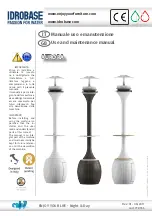
2
RAS
INTRODUCTION
APPROVALS
RAS
apparatus is ‘CE’ marked in accordance
with EEC Directive EC/686/1986.
It is approved to European Standard EN
14593-1:2005 (Respiratory Protective Devices -
Compressed air line breathing apparatus with
demand valve).
Facemasks are approved to EN136:1998.
Scott Safety
is quality assurance approved to:
ISO 9001.
Notified Body
BSI (0086)
Kitemark Court,
Davy Ave,
Knowlhill,
Milton Keynes,
MK5 8PP.
England
LIMITATIONS OF USE
RAS
must only to be used with
Scott Safety
breathing apparatus
Facemasks
.
Only to be used by competent personnel
trained by
Scott Safety
Instructors, or their
approved agents.
DO NOT use with spectacle side arms, beards
(or other facial hair), or clothing that may
prevent the facemask forming a good seal with
the face.
BREATHABLE AIR
Air used to supply or charge breathing air may
be natural or synthetic and must comply with
EN 12021:1999.
COMPRESSED AIR AIRLINE
SUPPLIES
Air for use with compressed air airlines must
conform to EN12021:1999.
Airline pressure must be between 5.0 - 9.0 bar
(70 - 130psi). Airflow supply capacity for a
single airline is given in Table 1. Generally - each
additional wearer requires an extra 150 litres/
minute, each additional pair of wearers requires
300 L/min for one wearer and 450 L/min for
two wearers (see Table 1). All measurements
must be taken at the wearer end of the airline.
An airline flow tester (Article Number 1035978)
is available from
Scott Safety
.
Example:
for 8 users (4 pairs) the recommended
flow is 4 x (300 + 150) = 1800 litres/minute.
Table 1 Wearer Air Consumption
No. of Wearers
Airflow (L/min.)
1
300
2
450
3
750
4
900
Airline hoses used with
Scott Safety
breathing
apparatus must be
Scott Safety
products,
approved to EN14593-1:2005.
PERSONNEL TRAINING
Personnel who use breathing apparatus must
be fully trained in accordance with Local
National Regulations and these instructions.
These instructions cannot replace an accredited
training course run by fully qualified instructors
in the proper and safe use of
Scott Safety
breathing apparatus.
Contact
Training & Technical Support Services
or a
Scott Safety
distributor for training
information.
Training & Technical Support Services,
Scott Safety
,
Pimbo Road, West Pimbo,
Skelmersdale, Lancashire,
WN8 9RA, United Kingdom.
Tel: +44 (0) 1695 711711
Fax: +44 (0) 1695 711775
SERVICING
RAS
must be serviced at scheduled intervals
by personnel who have completed a formal
training course and hold a current certificate
for the servicing and repair of
Scott Safety
breathing apparatus. Details of the servicing
schedule are contained in the
Scott Safety
RAS
Service Manual, copies of which can only
be obtained by registered holders of a current
certificate.
Your distributor or
Training and Technical
Support Services
at
Scott Safety
will be
pleased to provide training course details and
quotes for service contracts.
Summary of Contents for RAS
Page 1: ...RAS 2026506 A 02 2013 0086 ...
Page 13: ......





















